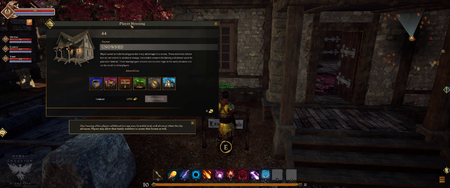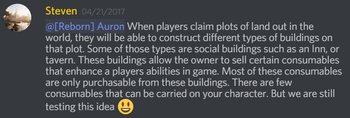Player housing
Housing types come in the form of static housing, instanced housing and open-world land ownership [1]. A player can own one of each type of housing [2]. It is possible for a player to claim citizenship to a node once it has developed to stage 3. A player can only claim citizenship to one node at a time. Changing citizenship has a cooldown of 2 weeks [3]
Static housing
Static housing provides non-instanced player accommodation within a node, also known as in-node housing.[5]
- Players are able to purchase small one room houses (cottages) starting at the Village (stage 3).[5][6]
- There will be 8 cottages available for purchase at the village stage.[6]
- The amount of static housing increases as a normal part of node advancement.[7]
- The architecture of static housing is predetermined by the racial influence of the node's layout and style.[8]
- Taverns and Player shops are not tied to in-node housing.[9]
Instanced housing
Instanced housing are also known as apartments. Apartments can be built at node stage 4 if the government chooses to do so.Template:Needs citation Apartments have a fixed size and shape, even if the node progresses.Template:Needs citation Players can rent out apartments which grants the player citizenship.Template:Needs citation The more players rent out apartments the higher their price scales. This is to deter all players from living in one node.Template:Needs citation
Freeholds
Freeholds are plots that can be placed in the open world, so long as the area falls under the Zone of Influence of a Stage 3 node or above. These plots allow players to build many different types of buildings[10], that have wide-ranging effects and abilities. Where these may be placed will be pretty much anywhere, so long as it does not overlay a spawn zone, road pathway, proximity zones to other plots, or hard terrain features such as mountainsides or cliffs.[11]
Taxes
When a node reaches stage 3 and a player run government has formed, all player housing will pay tax [12]. Tax money goes straight towards node funds in which the government can use towards node development spending. A players tax charge will be determined by the number of structures built on their plot [13].







